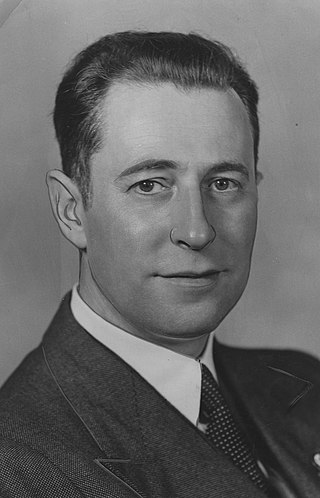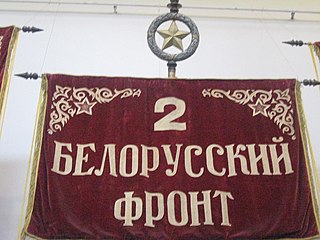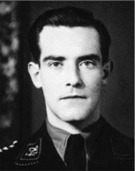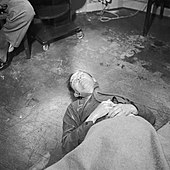
The Volkssturm was a levée en masse national militia established by Nazi Germany during the last months of World War II. It was set up by the Nazi Party on the orders of Adolf Hitler and established on 25 September 1944. It was staffed by conscripting males between the ages of 16 and 60 years, who were not already serving in some military unit. The Volkssturm comprised one of the final components of the total war promulgated by Propaganda Minister Joseph Goebbels, part of a Nazi endeavor to overcome their enemies' military strength through force of will. Volkssturm units fought unsuccessful battles against Allied forces at the end of the war and on several occasions, its members participated in atrocities accompanied by German civilians and the Hitler Youth, which were overseen by members of the SS or Gaue leaders.

Paul Joseph Goebbels was a German philologist and Nazi politician who was the Gauleiter of Berlin, chief propagandist for the Nazi Party, and then Reich Minister of Propaganda from 1933 to 1945. He was one of Adolf Hitler's closest and most devoted followers, known for his skills in public speaking and his deeply virulent antisemitism which was evident in his publicly voiced views. He advocated progressively harsher discrimination, including the extermination of the Jews in the Holocaust.

Werwolf was a Nazi plan which began development in 1944, to create a resistance force which would operate behind enemy lines as the Allies advanced through Germany in parallel with the Wehrmacht fighting in front of the lines. It is widely misconstrued as having been intended to be a guerrilla force to harass Allied forces after the defeat of Germany, a misconception created by Joseph Goebbels through propaganda disseminated in the waning weeks of the war through his "Radio Werwolf,” which was not actually connected in any way with the military unit.

August Franz Anton Hans Fritzsche was the Ministerialdirektor at the Propagandaministerium of Nazi Germany. He was the preeminent German broadcaster of his time, as part of efforts to present a more popular and entertaining side of the Nazi regime, and his voice was recognised by the majority of Germans.

Johanna Maria Magdalena "Magda" Goebbels was the wife of Nazi Germany's Propaganda Minister Joseph Goebbels. A prominent member of the Nazi Party, she was a close ally, companion, and political supporter of Adolf Hitler. Some historians refer to her as the unofficial "first lady" of Nazi Germany, while others give that title to Emmy Göring.

2nd Belorussian Front a major formation of the Soviet Army during World War II, being equivalent to a Western army group.

Adolf Hitler, chancellor and dictator of Germany from 1933 to 1945, signed his political testament and his private will in the Führerbunker on 29 April 1945, the day before he committed suicide with his wife, Eva Braun.

The Bunker, also published as The Berlin Bunker, is a 1975 account, written by American journalist James P. O'Donnell and German journalist Uwe Bahnsen, as to the history of the Führerbunker in 1945, as well as the last days of German dictator Adolf Hitler. The English edition was first published in 1978. Unlike other accounts O'Donnell focused considerable time on other, less-famous, residents of the bunker complex. Additionally, unlike the more academic works by historians, the book takes a journalistic approach. The book was later used as the basis for a 1981 CBS television film of the same name.

During World War II, the German Wehrmacht committed systematic war crimes, including massacres, mass rape, looting, the exploitation of forced labour, the murder of three million Soviet prisoners of war, and participated in the extermination of Jews. While the Nazi Party's own SS forces was the organization most responsible for the genocidal killing of the Holocaust, the regular armed forces of the Wehrmacht committed many war crimes of their own, particularly on the Eastern Front.
Until the Final Hour, also published as Until the Final Hour: Hitler's Last Secretary or simply Hitler's Last Secretary is a memoir of the last days of Hitler's government, written by Traudl Junge in 1947, but not published until 2002 and 2003. The book was part of the basis for the 2002 Austrian documentary Im toten Winkel - Hitlers Sekretärin and the film Der Untergang in 2004.

Hans-Erich Voss was a German Vizeadmiral and one of the final occupants of the Führerbunker during the battle of Berlin in 1945. He was also among the last people to see both Adolf Hitler and Joseph Goebbels alive before they committed suicide. After the war in Europe ended, he spent several years in prison in both the Soviet Union and East Germany.

Helmut Kunz was an SS dentist who, after the suicide of Adolf Hitler, was ordered to administer anesthetic to the six children of Joseph Goebbels before they were killed.

The following events occurred in May 1945:

Hans Krebs was a German Army general of infantry who served during World War II. A career soldier, he served in the Reichswehr and the Wehrmacht. He served as the last Chief of Staff of the Oberkommando des Heeres (OKH) during the final phase of the war in Europe. Krebs tried to open surrender negotiations with the Red Army; he committed suicide in the Führerbunker during the early hours of 2 May 1945, two days after Adolf Hitler killed himself.

After the Munich Agreement, the Soviet Union pursued a rapprochement with Nazi Germany. On 23 August 1939 the Soviet Union signed a non-aggression pact with Germany which included a secret protocol that divided Eastern Europe into German and Soviet "spheres of influence", anticipating potential "territorial and political rearrangements" of these countries. Germany invaded Poland on 1 September 1939, starting World War II. The Soviets invaded eastern Poland on 17 September. Following the Winter War with Finland, the Soviets were ceded territories by Finland. This was followed by annexations of the Baltic states and parts of Romania.

As Allied troops entered and occupied German territory during the later stages of World War II, mass rapes of women took place both in connection with combat operations and during the subsequent occupation of Germany by soldiers from all advancing Allied armies, although a majority of scholars agree that the records show that a majority of the rapes were committed by Soviet occupation troops. The wartime rapes were followed by decades of silence.
Josef Greiner was an Austrian writer. He supposedly knew Adolf Hitler during Hitler's time in Vienna and later published two memoirs on this topic, for which he is best known.
On 1 May 1945, hundreds of people killed themselves in the town of Demmin, in the Province of Pomerania, Germany. Although death toll estimates vary, it is acknowledged to be the largest mass suicide ever recorded in Germany. The suicide was part of a mass suicide wave amongst the population of Nazi Germany.
Events in the year 1945 in Germany.

Adolf Hitler's cult of personality was a prominent feature of Nazi Germany (1933–1945), which began in the 1920s during the early days of the Nazi Party. Based on the Führerprinzip ideology, that the leader is always right, promulgated by incessant Nazi propaganda, and reinforced by Adolf Hitler's success in fixing Germany's economic and unemployment problems by remilitarising during the global Great Depression, his bloodless triumphs in foreign policy prior to World War II, and the rapid military defeat of the Second Polish Republic and the Third French Republic in the early part of the war, it eventually became a central aspect of the Nazi control over the German people.



















